SPECIES INFO
Wingleaf soapberry (Sapindus saponaria) can be found in southern Florida and also in Mexico, and certainly further south to South America. This has been introduced into Hawaii. The pinnately compound leaves are unusual because there are distinctive wings on the leaf stem between the pairs of opposite blades.Soapberry (Sapindus) genus is native to the tropics and subtropics of both the Old and New Worlds. There are about 12-14 species of shrubs and trees in this genus. There has been considerable rearrangement of the North American species in this genus: Kartesz shows only two species as living in his greater North America which includes Puerto Rico and the Virgin Islands.
Soapberry Family (Sapindaceae) is a family trees, shrubs, and some vines that are found in both the New and Old World tropics. There are over 130 genera and over 1100 species in this family. There are 18 different genera with 33 species and seven subspecies established in greater North America.
Sapindales Order is a diverse group of mostly trees and shrubs. In older taxonomic works there were about 25 different families in this order. Some modern authors retain only about 10 families. This order is very widespread in the world, and seemingly only absent from a few dry deserts.
Dicots (Dicotyledoneae Class) are the predominant group of vascular plants on earth. With the exception of the grasses (Monocots) and the Conifers (Gymnosperms), most of the larger plants that one encounters are Dicots. Dicots are characterized by having a seed with two outer shell coverings.
Some of the more primitive Dicots are the typical hardwood trees (oaks, birches, hickories, etc). The more advanced Dicots include many of the Composite (Aster) Family flowers like the Dandelion, Aster, Thistles, and Sunflowers. Although many Monocots reach a very high degree of specialization, most botanists feel that the Dicots represent the most advanced group of plants.
Seed plants (Phylum Embryophyta) are generally grouped into one large phylum containing three major classes: the Gymnosperms, the Monocots, and the Dicots. (Some scientists separate the Gymnosperms into a separate phylum and refer to the remaining plants as flowering plants or Angiospermae.)
For North American counts of the number of species in each genus and family, the primary reference has been John T. Kartesz, author of A Synonymized Checklist of the Vascular Flora of the United States, Canada, and Greenland (1994). The geographical scope of his lists include, as part of greater North America, Hawaii, Alaska, Greenland, Puerto Rico, and the Virgin Islands.
Kartesz lists 21,757 species of vascular plants comprising the ferns, gymnosperms and flowering plants as being found in greater North America (including Alaska, Hawaii, Greenland, Puerto Rico and the Virgin Islands.
There are estimates within the scientific world that about half of the listed North American seed plants were originally native with the balance being comprised of Eurasian and tropical plants that have become established.
Plant kingdom contains a large variety of different organisms including mosses, ferns, and seed plants. Most plants manufacture their energy from sunlight and water. Identification of many species is difficult in that most individual plants have characteristics that have variables based on soil moisture, soil chemistry, and sunlight.
Because of the difficulty in learning and identifying different plant groups, specialists have emerged that study only a limited group of plants. These specialists revise the taxonomy and give us detailed descriptions and ranges of the various species. Their results are published in technical journals and written with highly specialized words that apply to a specific group.
On the other hand, there are the nature publishers. These people and companies undertake the challenging task of trying to provide easy to use pictures and descriptions to identify those species.


